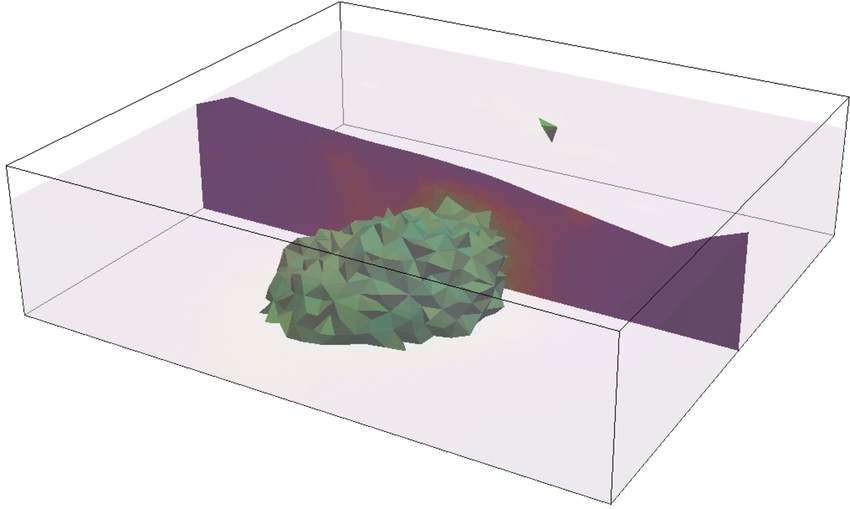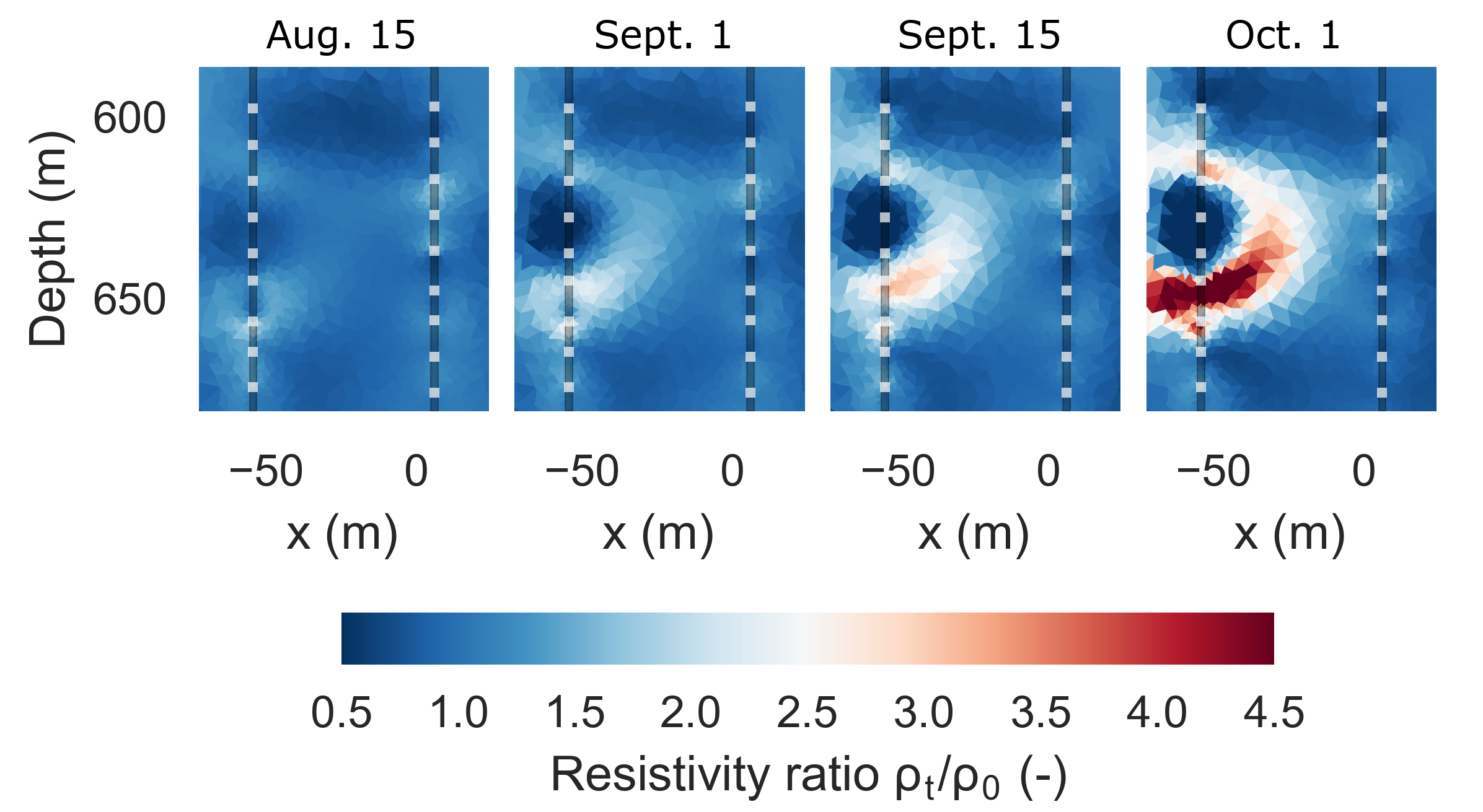Research focus areas
At GIM we combine multiple geophysical measurement methods for high resolution imaging and monitoring of subsurface structures and processes.
Multi-method geophysical imaging and data integration
The interpretation of subsurface images based on a single geophysical method is often ambiguous, since a multitude of models can explain the observations made in the field.
At GIM we develop computational approaches to combine multiple geophysical data sets to exploit the complementary sensitivities of different geophysical methods and increase the resolution of the resulting images. These data integration approaches, such as joint inversion, aim at finding a common subsurface model, which is in agreement with multiple (ideally all) geophysical (and non-geophysical) observations. The coupling between the geophysical methods involved can be of structural nature or linked via rock physical properties.
Exemplary publication
-
Quantitative imaging of water, ice and air in permafrost systems through petrophysical joint inversion of seismic refraction and electrical resistivity data
2019 |
Geophysical Journal International, doi:10.1093/gji/ggz402
RWTH Publications PDFNote: This publication resulted from Florian's time at the University of Bonn, i.e. was prepared before GIM was founded.Abstract
Quantitative estimation of pore fractions filled with liquid water, ice and air is crucial for a process-based understanding of permafrost and its hazard potential upon climate-induced degradation. Geophysical methods offer opportunities to image distributions of permafrost constituents in a non-invasive manner. We present a method to jointly estimate the volumetric fractions of liquid water, ice, air and the rock matrix from seismic refraction and electrical resistivity data. Existing approaches rely on conventional inversions of both data sets and a suitable a priori estimate of the porosity distribution to transform velocity and resistivity models into estimates for the four-phase system, often leading to non-physical results. Based on two synthetic experiments and a field data set from an Alpine permafrost site (Schilthorn, Bernese Alps and Switzerland), it is demonstrated that the developed petrophysical joint inversion provides physically plausible solutions, even in the absence of prior porosity estimates. An assessment of the model covariance matrix for the coupled inverse problem reveals remaining petrophysical ambiguities, in particular between ice and rock matrix. Incorporation of petrophysical a priori information is demonstrated by penalizing ice occurrence within the first two meters of the subsurface where the measured borehole temperatures are positive. Joint inversion of the field data set reveals a shallow air-rich layer with high porosity on top of a lower-porosity subsurface with laterally varying ice and liquid water contents. Non-physical values (e.g. negative saturations) do not occur and estimated ice saturations of 050 per cent as well as liquid water saturations of 1575 per cent are in agreement with the relatively warm borehole temperatures between −0.5 and 3 ° C. The presented method helps to improve quantification of water, ice and air from geophysical observations.
Cite as
Wagner, F. M. and Mollaret, C. and Günther, T. and Kemna, A. and Hauck, C. (2019): Quantitative imaging of water, ice and air in permafrost systems through petrophysical joint inversion of seismic refraction and electrical resistivity data. Geophysical Journal International. https://doi.org/10.1093/gji/ggz402
Quantitative process monitoring
When applied in a time-lapse manner, applied geophysical methods enable the non-invasive monitoring of subsurface processes, such as fluid migration in subsurface reservoirs. While changes in geophysical parameters such as seismic velocity or electrical resistivity can qualitatively illuminate subsurface regions affected by the monitored process, quantitative information on the process is often desired.
At GIM we develop and apply methods to estimate process-relevant subsurface properties from multi-method time-lapse geophysical data. Paired with careful experimental design, data processing, choice of inversion parameters, and petrophysical models based on laboratory measurements, our methods can be used estimate process-relevant subsurface properties for improved process understanding and predicition.
Exemplary publication
-
Fully coupled inversion on a multi-physical reservoir model Part II: The Ketzin CO2 storage reservoir
2018 |
International Journal of Greenhouse Gas Control, doi:10.1016/j.ijggc.2018.04.009
RWTH Publications PDFNote: This publication resulted from Florian's time at GFZ Potsdam, i.e. was prepared before GIM was founded.Abstract
Reliable monitoring of CO2 storage reservoirs requires a combination of different observation methods. However, history matching is typically limited to CO2 pressure data alone. This paper presents a multi-physical inversion of hydraulic pressure, CO2 pressure, CO2 arrival time and geoelectrical crosshole observations of the Ketzin pilot site for CO2 storage, Germany. Multi-physical inversion has rarely been reported for CO2 storage reservoirs. In contrast to previous studies, there is no need for pre-inversion of geophysical datasets as these are now directly included in a fully coupled manner. The deteriorating impact of structural noise is effectively mitigated by preconditioning of the observation data. A double regularisation scheme provides stability for insensitive parameters and reduces the number of required model runs during inversion. The model shows fast and stable convergence and the results provide a good fit to the multi-physical observation dataset. It has certain predictive power as the known migration direction of the CO2 plume is captured. These results clarify two long discussed issues of the Ketzin CO2 storage reservoir: (1) The pre-existing hypothesis of an existing hydraulic barrier became unsubstantial as the data series suggesting weak hydraulic communication are identified as erroneous. (2) Salt precipitation around the injection well doubles the injection overpressure compared to salt free conditions, which is equivalent to a well skin of 10. The presented framework allows to integrate various types of observations into a single multi-physical model leading to an increased confidence in the spatial permeability distribution and, in perspective, to improved predictive assessments of CO2 storage reservoirs.
Cite as
Wagner, F. M. and Wiese, B. U. (2018): Fully coupled inversion on a multi-physical reservoir model Part II: The Ketzin CO2 storage reservoir. International Journal of Greenhouse Gas Control. https://doi.org/10.1016/j.ijggc.2018.04.009
Optimized experimental design
While novel processing and data analysis frameworks can push the limits of geophysical data, the maximum information content of each geophysical survey is ultimately limited by its layout.
At GIM we develop optimized experimental design (OED) approaches to find optimum source and sensor locations that maximize spatial and temporal resolutions of individual applied geophysical imaging and monitoring methods as well as their combination. The goal is always to find an optimal tradeoff between costs (e.g., number of sensors and sources, time spent in the field) and benefit (e.g., model resolution).
Exemplary publication
-
Constructive optimization of electrode locations for target-focused resistivity monitoring
2015 |
Geophysics, doi:10.1190/geo2014-0214.1
RWTH Publications PDFNote: This publication resulted from Florian's time at GFZ Potsdam, i.e. was prepared before GIM was founded.Abstract
Crosshole resistivity tomography has received consideration as a tool for quantitative imaging of carbon dioxide stored in deep saline aquifers. With regard to the monitoring responsibility of site operators and the substantial expenses associated with permanent downhole installations, optimized experimental design gains particular importance. Based on an iterative appraisal of the formal model resolution matrix, we developed a method to estimate optimum electrode locations along the borehole trajectories with the objective to maximize the imaging capability within a prescribed target horizon. For the presented crosshole case, these layouts were found to be symmetric, exhibiting refined electrode spacings within the target horizon. Our results revealed that a sparse but well conceived set of electrodes can provide a large part of the information content offered by comparably dense electrode distributions. In addition, the optimized layout outperformed equidistant setups with the same number of electrodes because its resolution was focused on the monitoring target. The optimized electrode layouts presented provided a powerful and cost-efficient opportunity to complement permanent installations, particularly at, but not limited to, future CO2 storage sites. Although preliminarily developed to support the design of crosshole resistivity layouts, our approach is directly applicable to other survey geometries including surface and surface-to-hole acquisitions.
Cite as
Wagner, F. M. and Günther, T. and Schmidt-Hattenberger, C. and Maurer, H. (2015): Constructive optimization of electrode locations for target-focused resistivity monitoring. Geophysics. https://doi.org/10.1190/geo2014-0214.1



